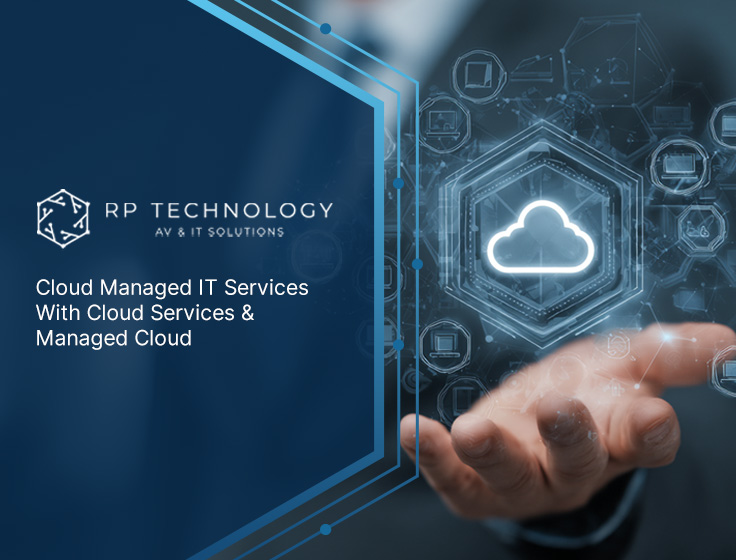
If your organization manages between 25 and 200 endpoints, understanding and maintaining your IT infrastructure is essential to business continuity and growth. IT infrastructure services help ensure your systems stay reliable, secure, and scalable. This blog will guide you through the core components, types, and benefits of these services, especially if you're planning to modernize or expand.
If you have 20 or more employees on your team, this blog is for you. We’ll also touch on related areas like cloud services, infrastructure management, and how to optimize your server and network infrastructure for long-term success. Topics like managed services, data center efficiency, and cyber readiness will also be covered.
What are IT infrastructure services?
IT infrastructure services refer to the setup, management, and support of the technology systems that keep your business running. This includes hardware like servers and networking equipment, as well as software, cloud platforms, and security tools.
These services are vital for businesses that rely on digital tools to operate. They ensure that systems are always available, secure, and performing well. Whether you're using on-premises equipment or cloud-based platforms, having the right infrastructure in place supports your daily operations and long-term goals.

The importance of IT infrastructure: Core components and functions
A strong IT infrastructure supports every part of your business. Let’s explore the different components and how they work together.
Servers and storage
Servers host your applications and store your data. They can be physical machines or virtual systems in the cloud. Storage systems ensure your data is accessible and backed up.
Network infrastructure
This includes routers, switches, firewalls, and cabling. A reliable network ensures fast and secure communication between devices and systems.
Cloud integration
Many businesses use cloud platforms to reduce costs and increase flexibility. Cloud infrastructure allows you to scale resources as needed without large upfront investments.
Security tools
Firewalls, antivirus software, and intrusion detection systems protect your data and systems from cyber threats.
Monitoring and automation
Monitoring tools track system performance and detect issues early. Automation helps reduce manual tasks and improves consistency.
Disaster recovery systems
These systems ensure your data and applications can be restored quickly after an outage or cyberattack.
User access and identity management
This controls who can access what within your systems, helping to prevent unauthorized use and data breaches.
Key benefits of reliable IT infrastructure services
A well-managed IT infrastructure brings several advantages:
- Improved system uptime and fewer disruptions to business operations
- Faster response to technical issues through proactive monitoring
- Better scalability to support business growth and changing needs
- Enhanced data protection and compliance with industry standards
- Cost savings through efficient resource use and automation
- Stronger defense against cyber threats and data loss

Types of IT infrastructure and how they meet business needs
There are different types of IT infrastructure, and each serves specific business needs. On-premises infrastructure involves physical hardware located at your office or data center. It offers control but requires more maintenance.
Cloud-based infrastructure provides flexibility and scalability. It’s ideal for businesses that want to avoid large capital expenses. Hybrid infrastructure combines both, giving you the benefits of each.
Choosing the right setup depends on your goals, budget, and technical requirements. For example, businesses in West Covina, California may prefer cloud options to reduce local hardware costs while maintaining performance.
Exploring types of IT infrastructure services in detail
IT infrastructure services cover a wide range of support areas. Here’s a closer look at the most common types.
Managed network services
These services handle the setup, monitoring, and maintenance of your network. They ensure secure and reliable connectivity.
Cloud infrastructure services
These include cloud storage, computing, and backup solutions. They allow businesses to scale quickly and reduce hardware costs.
Server management
This involves maintaining your physical or virtual servers, including updates, patches, and performance monitoring.
Security and compliance
These services protect your systems from threats and help you meet regulatory requirements.
Infrastructure monitoring
Tools and services that track the health and performance of your systems in real time.
Help desk and support
Technical support services that assist your team with IT issues and questions.
Service management platforms
These tools help organize and automate IT tasks, improving efficiency and accountability.

Choosing the right IT infrastructure services for your business
Selecting the right services starts with understanding your current setup and future goals. Consider your team size, the complexity of your systems, and your growth plans. Businesses with 25-200 endpoints often benefit from a mix of cloud and on-premises solutions.
You should also evaluate your need for automation, scalability, and disaster recovery. Working with a provider that understands your industry can help you avoid common pitfalls and infrastructure challenges.
Best practices for implementation and management
Implementing IT infrastructure services requires planning and ongoing management. Start with a clear assessment of your current systems. Identify gaps in performance, security, and scalability.
Next, define your goals. Are you aiming to reduce downtime, improve security, or support remote work? Choose services that align with these goals. Finally, monitor your systems regularly and update them as needed. This helps you stay ahead of issues and adapt to new business needs.
Best practices for managing IT infrastructure
Here are some guidelines to keep your infrastructure running smoothly:
- Conduct regular system audits to identify outdated or underperforming components
- Use automation to reduce manual tasks and improve consistency
- Implement strong access controls to protect sensitive data
- Schedule regular backups and test your disaster recovery plan
- Monitor performance metrics to catch issues early
- Train staff on basic IT protocols and security awareness
Following these steps helps ensure your infrastructure supports your goals and adapts to change.

How RP Technology can help with IT infrastructure services
If you're managing 25 to 200 endpoints, you likely face challenges with system reliability, security, and scaling. That’s where I come in. At RP Technology, we specialize in IT infrastructure services that are tailored to your business size and industry. Whether you need help with cloud migration, server management, or network security, we’ve got you covered.
I work directly with businesses like yours to assess current systems, identify gaps, and implement solutions that work. With our IT infrastructure management expertise, you’ll gain peace of mind knowing your systems are secure, optimized, and ready to grow with you.
Frequently asked questions
What is an infrastructure service and why does it matter?
An infrastructure service includes the tools and support that keep your IT systems running. This can involve cloud services, managed services, and server support. These services ensure your business stays online and secure.
For businesses with 25-200 endpoints, infrastructure services reduce downtime and improve performance. They also help you scale systems as your team grows. A reliable infrastructure is essential for daily operations and long-term success.
Why is the importance of IT infrastructure growing?
As more businesses rely on digital tools, the importance of IT infrastructure increases. Without a solid foundation, even basic tasks can become unreliable. Infrastructure management helps prevent these issues.
With tools like intrusion detection and disaster recovery, your systems stay protected. These services also support scalability and automation, which are key for growing companies.
How does cloud technology support small to mid-sized businesses?
Cloud platforms offer flexibility and cost savings. You can scale resources up or down as needed, which is ideal for businesses with changing demands. Cloud-based systems also reduce the need for on-premises hardware.
Cloud services also improve accessibility and collaboration. Employees can work from anywhere, and data is stored securely. This makes cloud a smart choice for growing teams.
What are the main types of IT infrastructure?
There are three main types: on-premises, cloud-based, and hybrid. On-premises involves physical servers and equipment. Cloud-based uses internet-hosted resources. Hybrid combines both.
Each type has pros and cons. On-premises offers control, while cloud-based provides flexibility. Hybrid setups offer a balance, making them popular among mid-sized businesses.
How do I align IT services with business needs?
Start by assessing your current systems and identifying gaps. Then, choose services that support your goals—whether that’s improving security, reducing costs, or enabling remote work.
Managed services can help you meet these goals. They offer expert support and reduce the burden on your internal team. This alignment ensures your infrastructure supports your business strategy.
What are common infrastructure challenges for growing companies?
Growing companies often face issues like outdated hardware, limited scalability, and weak security. These problems can slow growth and increase risks.
Using modern tools like automation and cyber protection helps address these challenges. Regular audits and updates also keep your systems aligned with business needs.








